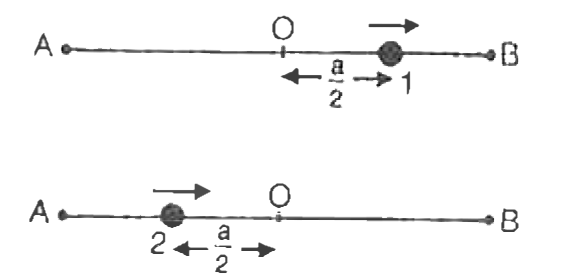Two mutually perpendicular simple harmonic vibrations have same amplitude, frequency and phase. When they superimpose, the resultant form of vibration will be
A circle
An ellipse
A straight line
A parabola
The correct Answer is:C
To solve the problem of finding the resultant form of vibration when two mutually perpendicular simple harmonic motions (SHM) with the same amplitude, frequency, and phase superimpose, we can follow these steps:
1. Identify the SHM equations:
Let the first simple harmonic motion be represented as:
Y1=Asin(ωt)
Since the second SHM is mutually perpendicular and has the same amplitude, frequency, and phase, we can represent it as:
Y2=Asin(ωt+90∘)
2. Convert the second SHM:
The sine function can be expressed in terms of cosine for a phase shift of 90 degrees:
Y2=Acos(ωt)
3. Superimpose the two SHMs:
The resultant displacement Y when these two motions are superimposed can be expressed as:
Y=Y1+Y2=Asin(ωt)+Acos(ωt)
4. Factor out the amplitude:
We can factor out A:
Y=A(sin(ωt)+cos(ωt))
5. Use the trigonometric identity:
To combine the sine and cosine terms, we can use the identity:
sin(x)+cos(x)=√2sin(x+45∘)
Therefore, we can rewrite Y as:
Y=A√2sin(ωt+45∘)
6. Conclusion:
The resultant form of the vibration when the two SHMs superimpose is:
Y=A√2sin(ωt+45∘)
Final Result:
The resultant form of vibration will be a simple harmonic motion with an amplitude of A√2 and a phase shift of 45∘.
Let the first simple harmonic motion be represented as:
Y1=Asin(ωt)
Since the second SHM is mutually perpendicular and has the same amplitude, frequency, and phase, we can represent it as:
Y2=Asin(ωt+90∘)
The sine function can be expressed in terms of cosine for a phase shift of 90 degrees:
Y2=Acos(ωt)
The resultant displacement Y when these two motions are superimposed can be expressed as:
Y=Y1+Y2=Asin(ωt)+Acos(ωt)
We can factor out A:
Y=A(sin(ωt)+cos(ωt))
To combine the sine and cosine terms, we can use the identity:
sin(x)+cos(x)=√2sin(x+45∘)
Therefore, we can rewrite Y as:
Y=A√2sin(ωt+45∘)
The resultant form of the vibration when the two SHMs superimpose is:
Y=A√2sin(ωt+45∘)
The resultant form of vibration will be a simple harmonic motion with an amplitude of A√2 and a phase shift of 45∘.
Topper's Solved these Questions
- SIMPLE HARMONIC MOTIONBOOK - ERRORLESS CHAPTER - SIMPLE HARMONIC MOTIONEXERCISE - Graphical Questions
16 Videos
- SIMPLE HARMONIC MOTIONBOOK - ERRORLESS CHAPTER - SIMPLE HARMONIC MOTIONEXERCISE - Assertion & Reason
23 Videos
- SIMPLE HARMONIC MOTIONBOOK - ERRORLESS CHAPTER - SIMPLE HARMONIC MOTIONEXERCISE - spring pendulum
55 Videos
- ROTATIONAL MOTIONBOOK - ERRORLESS CHAPTER - ROTATIONAL MOTIONEXERCISE - Practice Problems (Problems based on motion of connected mass)
10 Videos
- SURFACE TENSIONBOOK - ERRORLESS CHAPTER - SURFACE TENSIONEXERCISE - Exercise
214 Videos
Similar Questions
Knowledge Check
Two mutually perpendicular simple harmonic vibrations have same amplitude, frequency and phase. When they superpose, the resultant form of vibration will be
Aa circleBa straight lineCa parabolaDan elipseWhen two mutually perpendicular simple harmonic motions of same frequency, amplitude and phase are susperimposed
Athe resulting motion is uniform circular motion.Bthe resulting motion is a linear simple harmonic motions along a straight ine inclined equally to the straight lines of motion of component ones.Cthe resulting motion is an elliptical motion, susmmetical about the lines of motion of the compounents.Dthe two S.H.M. will cancel each other.In a simple harmonic mode of vibration, on a string
AOne loop is formedBHalf loop is formedCTwo loops are formedDThree loops are formed
Two simple harmonic motions with the same frequency act on a particle at right angles i.e., along X-axis and Y-axis. If the two amplitudes are equal and the phase difference is π/2, the resultant motion will be
View SolutionTwo particles execute simple harmonic motion of the same amplitude and frequency along close parallel lines. They pass each other moving in opposite directions each time their displacement is half their amplitude. Their phase difference is
View SolutionWhen two simple harmonic motions of same periods, same amplitude, having phase difference of 3π/2, and at right angles to each other are super imposed, the resultant wave from is a
View SolutionTwo simple harmonic motion of angular frequency 100and1000rads−1 have the same displacement amplitude The ratio of their maximum acceleration is
View SolutionThe resultant of two rectangular simple harmonic motion of the same frequency and unequal amplitude but differing in phase by π/2 is
View Solution

